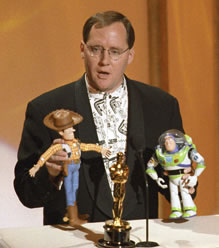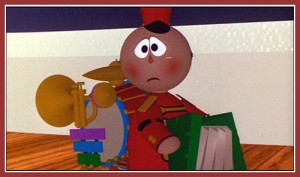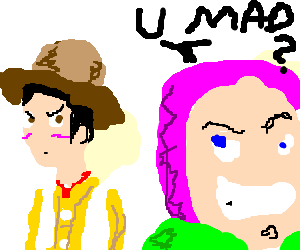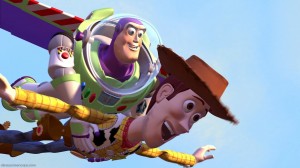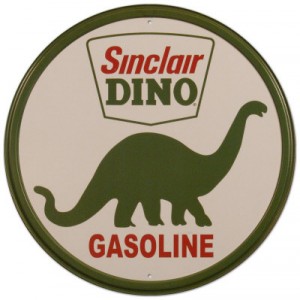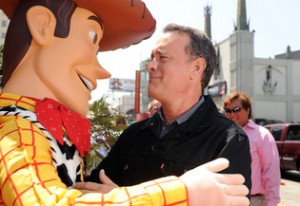100 Film Favorites – #41: Toy Story
(John Lasseter, 1995)
In the last post I mentioned a relative shortage of Disney so far (well, except for Dead Man’s Chest, Holes, Ernest Saves Christmas (through Touchstone), Atlantis, Wreck-It Ralph, Mickey’s Christmas Carol, Darby O’ Gill & The Little People, and National Treasure) Okay, so maybe there hasn’t exactly been a shortage of Disney films in general, but rather of the animated films of the Disney Renaissance era, which are frequently alluded to as part of the vast nostalgiagasm everyone seems to be having of late while recollecting the 90s. Today’s selection, like Beauty and the Beast, fits squarely into this latter category.
As such, Toy Story is another film many of you likely know inside and out. Within the world of the film, toys are sentient beings who only act lifeless when humans are present. Most toys’ primary desire in “life” is to be loved and played with by children. The story specifically follows the toys of a young boy named Andy. The protagonist, a pullstring cowboy doll named Woody, holds the coveted title of “favorite toy,” and thus has a position of leadership among Andy’s playthings.
The film begins with preparations underway for Andy’s birthday, as Woody leads the toys in following standard birthday procedure: a squadron of plastic army men broadcast back to Andy’s room the nature of each birthday gift as it is unwrapped. In the room, the other toys listen with baited breath, anxious that a particularly stellar birthday present might “replace them” in Andy’s eyes. Woody assures the toys that there is nothing to worry about. He soon eats those words, however – Andy receives a brand-new Buzz Lightyear action figure, which quickly replaces Woody himself as Andy’s favorite toy.
The other toys are awed by Buzz, a “Space Ranger” figure with many electronic and interactive features. But Woody is sorely vexed by Buzz’s usurpation of his throne. One evening, when Andy is told he may bring one toy to Pizza Planet, a restaurant/arcade similar to Chuck E. Cheese’s, a jealous Woody plots to knock Buzz behind a dresser, so that Andy will have to pick Woody for the trip. Instead, Woody’s calculations are off and his trap launches Buzz out the window and into the yard below. The other toys are furious and declare Woody a murderer, but he’s spared the wrath of their vigilante justice when Andy reluctantly takes him along on the ride to Pizza Planet. Buzz has stowed away in the car and ambushes Woody when Andy and his mom stop at a gas station. In their scuffle, the toys fall from the car and are “lost” as Andy and his mom drive away.
Woody blames their predicament on Buzz’s delusion – For some reason, Buzz is unique among the toys in that he believes himself to really be the character he represents: “Buzz Lightyear of Star Command,” a Space Ranger dedicated to protecting the universe from “the Evil Emperor Zerg, sworn enemy of the Galactic Alliance!” Woody rejects this assertion.
Though they eventually make their way to Pizza Planet, Buzz and Woody become trapped inside a claw machine and are won as “double prizes” by Sid, Andy’s maladjusted next-door neighbor. Sid is notorious for torturing his toys…which is just what he proceeds to do. Seriously, this film treads some dark water, showing Sid burning a hole into Woody’s head by focusing the rays of the sun through a magnifying glass. He plots a fate for Buzz as well: sending him “into orbit” by strapping him to an exploding rocket.
Buzz and Woody must learn to work together to escape Sid’s house, which proves harder once Buzz makes the world-shattering realization that he really is a toy and not a bonafide Space Ranger. However, Woody is able to convince Buzz that being beloved by a child is even better than hot-rodding around the universe, and with the help of Sid’s mutilated toys, the duo is able to execute an escape. After a rocket-powered pursuit of a moving van (Andy’s moving away, adding urgency to the toys’ journey), Woody and Buzz are reunited with the rest of Andy’s toys.
The film jumps forward to the following Christmas in the new house. Woody and Buzz have reconciled their differences and become the best of friends. With the army men’s broadcast playing in the background, the cowboy and the spaceman assure one another that at least one of them will always be Andy’s favorite. The film ends with the sounds of Andy opening a gift: A PUPPY! Buzz and Woody exchange an anxious glance.
It should come as little surprise that much of Toy Story‘s acclaim stems from its historic role as the first fully computer-animated feature film. It is perhaps the most innovative and pioneering feature in the history of animation since 1937’s Snow White and the Seven Dwarfs.
Director John Lasseter had originally pitched the idea of making completely computer-animated films while an animator at Disney in the early 80s. He worked on concepts for a CG adaptation of The Brave Little Toaster, but since he was pouring time into a project not yet officially greenlit, young upstart Lasseter was fired by Disney. He went on to join the computer graphics branch of Lucasfilm, which would soon be called Pixar, known for its top-of-the-line imaging computers. Pixar was purchased by Apple mogul Steve Jobs in 1986, and Lasseter began producing computer-animated short films soon after. One of his most successful efforts, 1988’s Tin Toy, won the Academy Award for Best Animated Short Subject. Intrigued by the new animation style’s success, the suits at Disney endeavored to get Lasseter back. Realizing that would be impossible, they instead opted to partner with Pixar to produce a film, directed by Lasseter and based around a similar premise to Tin Toy, which also featured living toys.
The film’s production was long and arduous, drawn out by the fact that Pixar’s story concepts were continually shot down and tweaked by Disney chairman Jeffrey Katzenberg (who would soon go on to found Dreamworks [SKG] with Steven Spielberg and David Geffen). Katzenberg and CEO Michael Eisner repeatedly insisted that the film needed to be more “edgy” to appeal to a wider audience. The result was a film in which the characters were “unpleasant and mean,” and Woody especially was “a real jerk.” Production was halted for a period of several months, during which Lasseter requested to be able to revise the script. He brought aboard several screenwriters (including…wait for it…JOSS WHEDON) to shape the script into its present form, appealing to all ages by making the characters more likeable and the film more “family friendly.” Though neither Disney executives nor Steve Jobs had high expectations for the film’s earnings, Toy Story proved to be not only the highest-grossing film the weekend of its release, but the highest-grossing movie of all of 1995, raking in upwards of 350 million dollars. A lucrative relationship was established between Disney and Pixar, though each company’s role in their “partnership” would prove a tenuous issue for years afterward.
Beyond Toy Story‘s status as a trail-blazer in animation history, the film features strong performances, particularly by animation first-timers Tom Hanks (Woody) and Tim Allen (Buzz). The movie’s story is also engaging and well-constructed. As a child, I “understood” the action of the story more once Buzz and Woody were united in their efforts to work together and escape Sid’s clutches. Watching it now, I realize how much the intensity of Woody’s jealousy flew over my 5-year-old head. Beginning-of-the-movie Woody is envious and spiteful to an extent rarely seen in a Disney protagonist, but is made all the more sympathetic and real by expressing these negative human emotions.
I’m sure I could find more to say about the film, and the history of Pixar in general, but it can wait. This isn’t the last time Pixar will be making a Countdown appearance. Let it suffice to say that Toy Story is an expertly crafted film which successfully launched a new studio, and which has stood the test of time as one of the best and most influential films ever made.
Tidbits:
-The gas station brand and logo, “Dinoco,” is based on the Sinclair Oil logo, which featured a green dinosaur (it was also the namesake of the Sinclairs, the central family in the early 90s puppet-sitcom “Dinosaurs”). Dinoco appears again in the “Cars” films as a prominent brand of racing fuel.
-Many other “in-jokes” are established in “Toy Story” which have recurred in most or all subsequent Pixar features: Andy’s mom’s license plate reads “A113,” the room number of the animation classroom at CalArts, the Alma Mater of Lasseter and many of Pixar’s other head honchos.
-A Pizza Planet truck appears in every Pixar film, and John Ratzenberger (Hamm the piggy bank in “Toy Story”) voices a supporting character in every film.
-Woody’s official full name is Woody Pride.
-In supplemental media beyond the films, Woody is often voiced by Tom Hanks’ less successful and probably much cheaper brother, Jim Hanks. Jim also acted as body double for Tom in several scenes in Forrest Gump.
—
Brian Terrill is the host of television show Count Gauntly’s Horrors from the Public Domain. You can keep up with Brian’s 100 Film Favorites countdown here.





